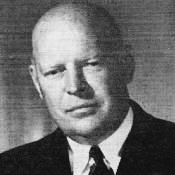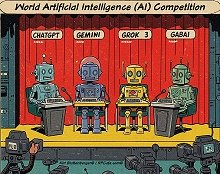Electronics Pioneers & History
- See Full List of AI Topics -

Allen B. DuMont, a pivotal figure in the early days of television and electronics,
was born on January 29, 1901, in Brooklyn, New York. His contributions to the advancement
of television technology, particularly through his work on cathode-ray tubes, and
the founding of the DuMont Television Network, left a lasting mark on the broadcasting
industry.
DuMont's early years were marked by adversity. As a young boy, he contracted
polio, which left him bedridden for several months. Despite the physical limitations
imposed by the disease, DuMont's intellectual curiosity flourished, and he turned
to reading and tinkering with electronics to occupy his time. This early exposure
to electrical engineering would shape his future.
DuMont's passion for electronics was evident from an early age. By the time he
was a teenager, he had built his own radio receiver. He attended Rensselaer Polytechnic
Institute (RPI), where he earned a degree in electrical engineering in 1924. His
formal education, combined with his practical experience in electronics, prepared
him to enter a rapidly evolving field that was poised for significant breakthroughs
in technology.
After graduation, DuMont began working for Westinghouse Lamp Company. During
his time there, he focused on improving the design of light bulbs, which honed his
skills in vacuum tube technology. However, his interest soon shifted to the burgeoning
field of radio and television technology, which would lead him to join the Radio
Corporation of America (RCA) in 1928.
At RCA, DuMont worked under the direction of Vladimir Zworykin, a Russian-American
engineer considered one of the fathers of television. This period was crucial in
refining DuMont's expertise in cathode-ray tube (CRT) technology. Zworykin's work
on early television systems greatly influenced DuMont, though DuMont's own innovations
in CRTs would eventually eclipse the contributions of his contemporaries. After
spending several years at RCA, DuMont grew frustrated with the company's management,
particularly its focus on radio rather than television, a technology in which DuMont
saw great potential.
In 1931, with only a few thousand dollars and working out of his garage, DuMont
founded Allen B. DuMont Laboratories, Inc. His goal was to develop and manufacture
superior cathode-ray tubes, which were critical components for televisions and oscilloscopes.
His CRTs quickly gained a reputation for their quality and durability, leading to
contracts with the U.S. government, universities, and private companies.
The early success of DuMont Laboratories in the CRT market allowed the company
to expand its operations. By 1938, DuMont was producing complete television sets,
becoming one of the first manufacturers in the United States to do so. His foresight
in recognizing the commercial potential of television at a time when most Americans
still relied on radio for news and entertainment was one of his greatest strengths.
In 1946, DuMont took his ambitions further by founding the DuMont Television Network,
a pioneering venture that sought to challenge the dominance of NBC and CBS.
The DuMont Television Network was revolutionary in several ways. It was the first
to air a live sporting event, the first to hire a female television news anchor,
and the first to broadcast programs five nights a week. Despite these innovations,
the network faced numerous financial challenges. Unlike NBC and CBS, which had strong
radio divisions to subsidize their early television operations, DuMont had no such
cushion. His network relied entirely on revenue from television, a medium that was
still in its infancy.
A major hurdle DuMont faced was RCA's monopoly on key television patents. RCA,
which held patents on television cameras and receivers, required that DuMont pay
significant licensing fees for the use of its technology. This placed a heavy financial
burden on DuMont's operations, as RCA's dominance in patent ownership often led
to costly legal battles and limited technological flexibility.
One of the most significant blows to DuMont's network came from its relationship
with the Federal Communications Commission (FCC). In 1948, the FCC implemented a
freeze on new television station licenses, which hindered the network's ability
to expand. The FCC's decision, combined with the fact that DuMont's network lacked
the affiliate strength of NBC and CBS, contributed to the decline of the network
by the mid-1950s.
Despite these challenges, DuMont continued to innovate. His company developed
the first all-electronic TV receiver in 1938 and introduced the first home television
set with a direct-view screen larger than 15 inches. He also pioneered in areas
such as the development of radar during World War II. His work on radar technology,
which he conducted in collaboration with the U.S. military, was a critical contribution
to the war effort and earned him numerous accolades.
Financial difficulties, however, plagued DuMont's ventures. Although his television
manufacturing business initially flourished, the rapid growth of competitors such
as RCA, Philco, and Zenith, combined with the aforementioned patent disputes, eroded
his market share. In 1956, the DuMont Television Network ceased operations, marking
the end of DuMont's dream of creating a fourth major television network in the U.S.
Despite the closure of his television network, DuMont Laboratories remained a
key player in the electronics industry. The company shifted its focus to military
contracts and other specialized electronics, which kept the business afloat for
several more decades. Eventually, however, DuMont Laboratories was sold to Fairchild
Camera and Instrument in 1960, marking the end of an era for the company DuMont
had built from the ground up.
Throughout his life, DuMont held several patents related to television and radar
technology. His CRT patents were especially valuable, as they helped define the
standards for early television picture quality. However, his lack of legal resources
to defend against patent infringement by larger competitors hampered his ability
to capitalize fully on these innovations.
Allen B. DuMont's contributions to television and electronics earned him numerous
honors. He was awarded the IEEE Founders Medal and was inducted into the National
Inventors Hall of Fame. However, his professional successes were often overshadowed
by the financial struggles of his enterprises, which left him without the same level
of wealth or recognition as some of his peers.
DuMont was a modest man who, despite his achievements, lived a relatively quiet
personal life. He married Ethel DuMont, and the couple had two children. He maintained
a close relationship with his family throughout his life and was known for his humility
and dedication to his work. He never sought the limelight, preferring to focus on
his inventions and business ventures.
Allen B. DuMont passed away on November 14, 1965, at the age of 64. His legacy,
however, lives on through the many innovations he introduced to the world of television
and electronics. Though his television network is often overshadowed by larger,
more successful competitors, DuMont's pioneering spirit and technical genius played
a crucial role in shaping the modern broadcasting landscape. His contributions to
radar and television technology remain a testament to his vision and determination,
even in the face of overwhelming challenges.
 This content was generated by primarily
the ChatGPT (OpenAI), and/or
Gemini (Google), and/or
Arya (GabAI), and/or
Grok 3 (x.AI) artificial intelligence (AI) engine.
Some review was performed to help detect and correct any inaccuracies; however,
you are encouraged to verify the information yourself if it will be used for critical
applications. In some cases, multiple solicitations to the AI engine(s) was(were) used to assimilate
final content. Images and external hyperlinks have also been added occasionally.
Courts have ruled that AI-generated content is not subject to copyright restrictions,
but since I modify them, everything here is protected by RF Cafe copyright. Many
of the images are likewise generated and modified. Your use of this data implies
an agreement to hold totally harmless Kirt Blattenberger, RF Cafe, and any and all
of its assigns. Thank you. Here are the major categories. This content was generated by primarily
the ChatGPT (OpenAI), and/or
Gemini (Google), and/or
Arya (GabAI), and/or
Grok 3 (x.AI) artificial intelligence (AI) engine.
Some review was performed to help detect and correct any inaccuracies; however,
you are encouraged to verify the information yourself if it will be used for critical
applications. In some cases, multiple solicitations to the AI engine(s) was(were) used to assimilate
final content. Images and external hyperlinks have also been added occasionally.
Courts have ruled that AI-generated content is not subject to copyright restrictions,
but since I modify them, everything here is protected by RF Cafe copyright. Many
of the images are likewise generated and modified. Your use of this data implies
an agreement to hold totally harmless Kirt Blattenberger, RF Cafe, and any and all
of its assigns. Thank you. Here are the major categories.
Electronics & High Tech
Companies | Electronics &
Tech Publications | Electronics &
Tech Pioneers | Electronics &
Tech Principles |
Tech Standards Groups &
Industry Associations | Societal
Influences on Technology
|









